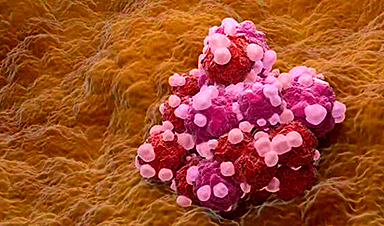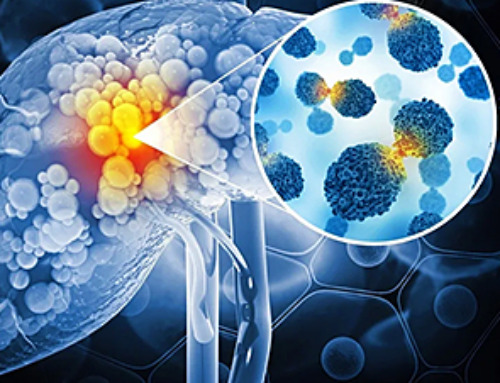Ovarian cancer ranks fifth in cancer deaths among women, accounting for more deaths than any other cancer of the female reproductive system. In a study conducted at Tel Aviv University, researchers used protein CKAP5 (cytoskeleton-associated protein) for the first time as a therapeutic target for RNA-based nanodrugs. After identifying a genetically unstable mutation resistant to both chemotherapy and immunotherapy in the tissues of ovarian cancer, the researchers targeted these cells with lipid nanoparticles containing RNA for silencing CKAP5—causing the cells to collapse and achieving an 80% survival rate in animal models.
Targeted delivery of RNA drug
The breakthrough was achieved by a TAU research team led by Prof. Dan Peer of The Shmunis School of Biomedicine and Cancer Research, a global pioneer in the development of RNA-based drugs, Head of the Laboratory of Precision Nanomedicine, and TAU’s VP for R&D; and by Dr. Sushmita Chatterjee, post-doctoral student from India at Prof. Peer’s lab, in collaboration with Prof. David Sprinzak of The George S. Wise Faculty of Life Sciences and Prof. Ronen Zaidel-Bar of the Sackler Faculty of Medicine. The results were published in the journal Science Advances.
“The protein CKAP5 has never been studied with relation to the fight against cancer, simply because there was no known way to silence it,” explains Dr. Chatterjee. “The lipid nanoparticles developed by Prof. Peer enabled us for the first time to silence this protein through targeted delivery of an RNA drug. We proved that CKAP5, a protein responsible for the cell’s stability, can be silenced, and that this procedure collapses and destroys the entire cancer cell.”
At the second stage of the study the researchers tested the new CKAP5-silencing RNA drug on 20 types of cancer. Some cancer cells proved more sensitive than others to this procedure. Cancers displaying high genetic instability, which are usually highly resistant to chemotherapy, were found to be especially sensitive to the silencing of CKAP5.
“As researchers, we are involved in something like a dominoes game: we always look for the one piece in the cancer’s structure that is so important, that if we pull it out the entire cell will collapse. CKAP5 is such a domino piece, and we are already working on more applications,” says Prof. Dan Peer.
“All cancer cells are genetically unstable,” says Dr. Chatterjee. “Otherwise, they would be healthy, not cancerous. However, there are different levels of genetic instability. We found that cancer cells that are more unstable, are also more affected by damage to CKAP5. Our drug pushed them to their limit, and essentially destroyed their structure. Our idea was to turn the trait of genetic instability into a threat for these cells, by using RNA to silence the flawed protein. We demonstrated for the first time that CKAP5 can be used to kill cancer cells, and then observed the biological mechanism that causes the cancer cells to collapse in the protein’s absence.”
Equipped with these insights, the researchers tested the new drug in an animal model for ovarian cancer, achieving a survival rate of 80%.
“We chose ovarian cancer because it’s a good target,” explains Prof. Peer. “While highly resistant to both chemotherapy and immunotherapy, this type of cancer is very sensitive to the silencing of CKAP5. It should be emphasized that the CKAP5 protein is a new target in the fight against cancer. Targeting cell division is not new, but using RNA to target proteins that make up the cell’s skeleton (cytoskeleton)—this is a new approach and a new target that must be further investigated. As researchers, we are involved in something like a dominoes game: we always look for the one piece in the cancer’s structure that is so important, that if we pull it out the entire cell will collapse. CKAP5 is such a domino piece, and we are already working on more applications, this time in blood cancers.”
News
The Stunning New Push to Protect the Invisible 99% of Life
Scientists worldwide have joined forces to build the first-ever roadmap for conserving Earth’s vast invisible majority—microbes. Their new IUCN Specialist Group reframes conservation by elevating microbial life to the same urgency as plants and [...]
Scientists Find a Way to Help the Brain Clear Alzheimer’s Plaques Naturally
Scientists have discovered that the brain may have a built-in way to fight Alzheimer’s. By activating a protein called Sox9, researchers were able to switch on star-shaped brain cells known as astrocytes and turn them into [...]
Vision can be rebooted in adults with amblyopia, study suggests
Temporarily anesthetizing the retina briefly reverts the activity of the visual system to that observed in early development and enables growth of responses to the amblyopic eye, new research shows. In the common vision [...]
Ultrasound-activated Nanoparticles Kill Liver Cancer and Activate Immune System
A new ultrasound-guided nanotherapy wipes out liver tumors while training the immune system to keep them from coming back. The study, published in Nano Today, introduces a biodegradable nanoparticle system that combines sonodynamic therapy and cell [...]
Magnetic nanoparticles that successfully navigate complex blood vessels may be ready for clinical trials
Every year, 12 million people worldwide suffer a stroke; many die or are permanently impaired. Currently, drugs are administered to dissolve the thrombus that blocks the blood vessel. These drugs spread throughout the entire [...]
Reviving Exhausted T Cells Sparks Powerful Cancer Tumor Elimination
Scientists have discovered how tumors secretly drain the energy from T cells—the immune system’s main cancer fighters—and how blocking that process can bring them back to life. The team found that cancer cells use [...]
Very low LDL-cholesterol correlates to fewer heart problems after stroke
Brigham and Women's Hospital's TIMI Study Group reports that in patients with prior ischemic stroke, very low achieved LDL-cholesterol correlated with fewer major adverse cardiovascular events and fewer recurrent strokes, without an apparent increase [...]
“Great Unified Microscope” Reveals Hidden Micro and Nano Worlds Inside Living Cells
University of Tokyo researchers have created a powerful new microscope that captures both forward- and back-scattered light at once, letting scientists see everything from large cell structures to tiny nanoscale particles in a single shot. Researchers [...]
Breakthrough Alzheimer’s Drug Has a Hidden Problem
Researchers in Japan found that although the Alzheimer’s drug lecanemab successfully removes amyloid plaques from the brain, it does not restore the brain’s waste-clearing system within the first few months of treatment. The study suggests that [...]
Concerning New Research Reveals Colon Cancer Is Skyrocketing in Adults Under 50
Colorectal cancer is striking younger adults at alarming rates, driven by lifestyle and genetic factors. Colorectal cancer (CRC) develops when abnormal cells grow uncontrollably in the colon or rectum, forming tumors that can eventually [...]
Scientists Discover a Natural, Non-Addictive Way To Block Pain That Could Replace Opioids
Scientists have discovered that the body can naturally dull pain through its own localized “benzodiazepine-like” peptides. A groundbreaking study led by a University of Leeds scientist has unveiled new insights into how the body manages pain, [...]
GLP-1 Drugs Like Ozempic Work, but New Research Reveals a Major Catch
Three new Cochrane reviews find evidence that GLP-1 drugs lead to clinically meaningful weight loss, though industry-funded studies raise concerns. Three new reviews from Cochrane have found that GLP-1 medications can lead to significant [...]
How a Palm-Sized Laser Could Change Medicine and Manufacturing
Researchers have developed an innovative and versatile system designed for a new generation of short-pulse lasers. Lasers that produce extremely short bursts of light are known for their remarkable precision, making them indispensable tools [...]
New nanoparticles stimulate the immune system to attack ovarian tumors
Cancer immunotherapy, which uses drugs that stimulate the body’s immune cells to attack tumors, is a promising approach to treating many types of cancer. However, it doesn’t work well for some tumors, including ovarian [...]
New Drug Kills Cancer 20,000x More Effectively With No Detectable Side Effects
By restructuring a common chemotherapy drug, scientists increased its potency by 20,000 times. In a significant step forward for cancer therapy, researchers at Northwestern University have redesigned the molecular structure of a well-known chemotherapy drug, greatly [...]
Lipid nanoparticles discovered that can deliver mRNA directly into heart muscle cells
Cardiovascular disease continues to be the leading cause of death worldwide. But advances in heart-failure therapeutics have stalled, largely due to the difficulty of delivering treatments at the cellular level. Now, a UC Berkeley-led [...]





















